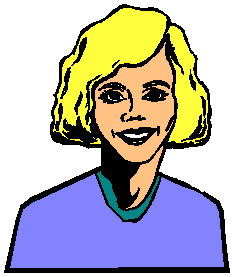French Level 1
Unit 11: Leçon 1c

|
Les Questions
|
In the last leçon I told you that I was going to show you more ways to make questions using some special phrases that are placed in front of a statement. You already know about the first phrase "est-ce que". The new phrase that I am going to show you is very similar to "est-ce que", it is "qu'est-ce que". The literal English translation for this French phrase is, "What is this that", however for our purposes we will simply say that "qu'est-ce que" means "what" in English.
The first part of the phrase or "qu'est-ce" is pronounced "kes". The second part of the phrase or "que" (which incidently is also the first part of "qu'est-ce" but we have dropped the "e" from "que" and added an apostrophe because the remaining part "est-ce" starts with a vowel) (Have you heard this "drop the "e" and replace it with an apostrophe before a vowel" rule enough times! AGHHHHH!). To form a question using "qu'est-ce que", we place the phrase at the beginning of a statement. Read and listen to the phrases on the next graph and you will learn what I mean.
(For this graph, we will be changing the outline from the graphs in the previous leçons. You will see a long answer to each question, followed by a short answer. The long answer is for practicing the words and structures of each of the responses. If you were to actually answer someone while speaking "en français", you would be much more likely to use the shorter answer.)
(One more thing. The translations are for the LONG answer.)
Commençons!
 Track 98 Track 98
Questions
(en français)
|
Answers
(en français)
|
Translations
(en anglais)
|
|
Qu'est-ce que tu manges?
|
1. Je mange un sandwich.
2. Un sandwich.
|
|
Q: What are you eating?
A: I am eating a sandwich.
|
|
|
Qu'est-ce que nous chantons?
|
1. Nous chantons des chansons du rock.
2. Des chansons du rock.
|
|
Q: What are we singing?
A: We are singing rock songs.
|
|
|
Qu'est-ce que vous regardez?
|
1. Je regarde une photo de mon chien.
2. Une photo de mon chien.
3. Une photo.
|
|
Q: What are you looking at?
A: I am looking at a picture of my dog.
|
|
|
Qu'est-ce qu'elle joue?
|
1. Elle joue du piano.
2. Du piano.
|
|
Q: What is she playing?
A: She is playing the piano.
|
|
|
Qu'est-ce qu'ils cherchent?
|
1. Ils cherchent le stylo.
2. Le stylo.
|
|
Q: What are they looking for?
A: They are looking for the pen.
|
|
I promise NOT to ask you why we drop the final "e" in "qu'est-ce que" before the words "elle" and "ils"because by now you already know the answer (it is the "starts with a vowel thing")!
You may have noticed that we do not say all of the letters in the words "est-ce que" and "qu'est-ce que". The reason we do not do this is the same as the reason we do not say consonants at the end of sentences. Let me explain.
Since the words "est" is followed by the word "ce", (the letter "c" which is not a vowel), the letter "t" in "est" is silent. The letter "s" in "est" is silent as well, since it is followed by the consonant "t". Thus the letters that we are actually saying when we say the phrase "est-ce que" are the first letter "e", the letter "c", the letter "q" and the final letter "e".
The word "qu'est-ce que" is nearly the same thing only with the letter "q" spoken at the beginning of the word, followed by the sounds of the letters "e" and "c", the second letter "q", and the final letter "e".
Let us move on to Leçon 2!

|